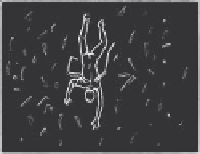Graphics Reference
In-Depth Information
too late, the train passes behind on a dif erent track. Keaton and his girl stand back, breathing
a huge sigh of relief with the audience, only for a beautifully timed second train to thunder in
from the left, destroying the house. This is the last straw, and Keaton puts a 'For Sale' sign on the
pile of rubble, and walks happily of into the sunset with his girl, thumbing his nose at the idea
of having to climb social ladders.
Keaton liked to let the audience think they had outguessed him, only for him to double-cross
them with an unexpected twist. This gag is funny for many reasons; funny because of all the
ef ort, funny because we just did not expect the second train, and funny because Keaton
brought the disaster on himself; the loser is never allowed to succeed.
The silent age was a gloriously inventive period, and the lack of sound, and especially dialogue,
meant that body language was paramount. Keaton earned his nicknames of 'stoneface'
and 'frozen face' (in France he was often called Frigo, after a make of refrigerator), with an
immobile face but wonderfully expressive eyes, like many of the puppets I have worked with.
Everything was done with a hunch of his shoulders, or a brilliantly timed double take, or a
daringly executed prat-fall. His characters were funnier the more serious they became. If I could
style my animation and storytelling on anyone it would probably be Keaton. His physicality
is astonishing, but there are also just as important moments of absolute stillness. The gags
were for real and never constructed in editing. Can you imagine how cheated the audience
would have felt if the shot had cut half way through the legendary falling house sequence in
Steamboat Bill Jnr
? We would have suspected that some cheat had happened, rendering the
stunt impotent. It has been copied many times, and sadly there is usually computer trickery
involved, and it's just not impressive. Like the train gag, Keaton used this falling house in
another movie, and it worked both times. It's a beautiful shot, made more so for Keaton's
total calm in the midst of the storm. In the bottom screen left window, there seems to be a
technician running away, presumably making the decision to let the huge house fall.
I also admire Keaton for always i nding a solid reason for a gag. If a gag dei ed science and
nature, he would i nd a pretext for that. Many of the gags in
Sherlock Jnr
are impossible
sight gags, but then they happen in his dream as a projectionist. Not all comedians have
this integrity, and I have to i nd logic to a gag even within the upturned logic of animation. I
cannot do a gag just because it is funny. It has to grow out of the character or the situation.
I like Keaton's melancholy, for which his face is perfect. Rejection is a common theme in his
i lms, but he seldom plays purely for sympathy. Rejection is expressed as something physical,
as many of the i lms includes scenes where he is thrown out of buildings, of trains, of the
stage, thrown out of a society he had aspirations to join. But there are few things funnier than
a well-timed prat-fall, and Keaton did these by the dozen. In reality there was a great sadness
to him, with failed marriages and a loss of control of his work, through studios telling him how
to perform. I am thrilled that his work has been rediscovered and seen as the brilliant pieces
they are. Most particularly, I was thrilled to meet his widow in 1995 and express my admiration.
Every animator can learn from his work. He moves with such clarity and elegance,
and every thought process is clear from his body. If I could only animate with half
that expression! He is the nearest thing to a living animated character, and the
link with animation is not far fetched at all. Like all the silent comedians he was
experimenting with every technique and inventing new ones if necessary. One
i lm has Keaton as a stop motion caveman, perched on the neck of a stop motion
dinosaur. I hope he animated that himself.


Search WWH ::

Custom Search